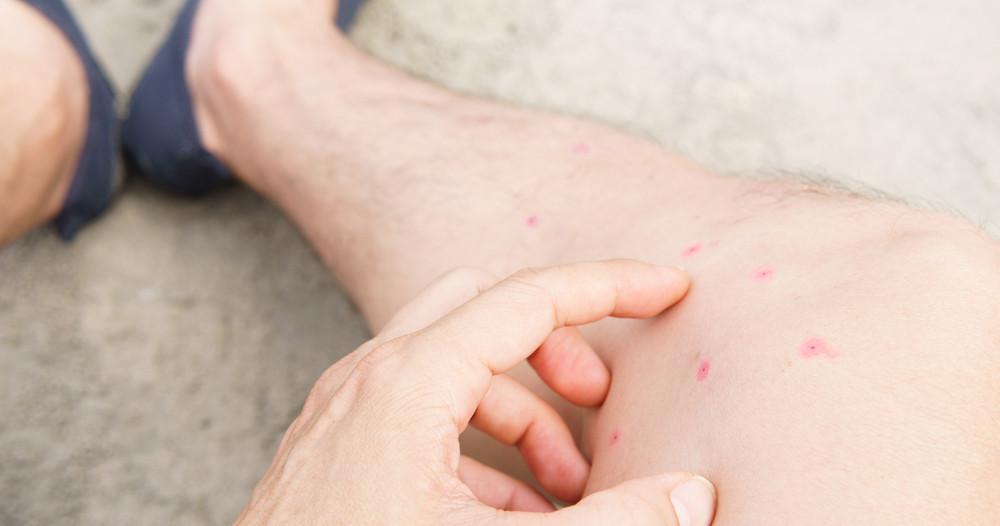Flea bite: symptoms and solutions to get rid of it
Bedding, cushions, parquet, rugs, curtains… Once they enter the house, fleas like to settle in fabrics and wood. They are most often found in the garden and on pets (dogs, cats). It is also our faithful companions who bring them into our interiors. These small brown insects move by jumping from one host to another. Female fleas bite humans and animals because they need blood to feed themselves and therefore to live.
How to recognize a flea bite?
Flea bites are characterized by small red pimples with a red circle around the point of the bite. Pimples are often clustered together or form a line on the skin. They cause severe itching and sometimes pain. Fleas usually bite the legs and ankles. You can also be bitten in the waist, armpits, groin, breasts or in the folds (behind the knees, elbow crease).
In dogs, flea bites form small white pimples that may be surrounded by a red circle. The infested animal also tends to scratch a lot, leaving red patches on its skin and hairless areas.
How to distinguish them from other insect bites?
Flea bites are different from bed bug bites. The bed bug settles in mattresses and carpets. It bites during the night and generally attacks exposed body parts (back, neck, legs, arms). Skin lesions appear as raised red spots with a red dot or blister of clear fluid in the center.
Mosquito bites are characterized by larger pimples than flea bites. They itch a little less too.
Tick bites are itchy and are characterized by redness around the bite. We also notice a black dot, a sign that the tick is still under the skin.

How do you know if you have fleas in your bed?
Bloodstains on sheets and clothing can be signs of bites and therefore a flea infestation. If you suspect a flea infestation in your home, look for nest(s) in places where these pests like to settle. Start by inspecting your pet if you have one. Also walk around your garden. Look on your carpets, cushions or even in the cat litter box. Little trick to detect fleas on your carpet: walk on it with white socks, if they are covered with tiny black insects, they are probably fleas.
How to treat flea bites on the body?
The bites are generally benign, they disappear without treatment. You can apply an antiseptic or soap and water to the bitten areas to prevent secondary infection from scratching. In some people, flea bites can cause allergic reactions. In this case, taking antihistamines is recommended.
The major risk with flea bites is the transmission of bacterial infections such as plague or typhus, or intestinal worms (young children become contaminated by putting their hands in their mouths after stroking an animal or playing on the ground).
If a bacterial infection is diagnosed, antibiotic treatment should be instituted promptly. Antiparasitics, available by prescription, are needed to get rid of intestinal worms.
The insect can also transmit cat-scratch disease to cats, which can subsequently be transmitted to humans by biting or scratching.
If your child or baby has flea bites, seek the advice of your doctor or pediatrician to relieve itching and discomfort.
In the presence of other symptoms such as fever, edema (hot to the touch or oozing), hives or difficulty in breathing, consult a doctor urgently. These are signs of a serious allergic reaction.
How to eliminate fleas?
The right reflexes to get rid of fleas: treat your pets and your home. Observe your pet's coat, you may find fleas or flea bites on their skin. Also, an animal that scratches more than usual can be a carrier of fleas. The treatment of animals involves the application of a shampoo and an anti-flea powder. Using a flea collar afterwards is also a good way to prevent them from coming back to infest your pet. Ask your veterinarian for advice before using any product.
As far as your house is concerned, start by vacuuming everywhere, insisting on fabrics (carpets, rugs, cushions, sofas) and under furniture (the larvae do not like light sources). Throw the bag away or empty the dust bin outside. Wash the floors with water and a detergent product to eliminate any flea larvae. Finally, wash your bedding (including that of the dog or cat) and your clothes at high temperature (60°C).
If all of these measures aren't enough to get rid of all the fleas in your home, hire a company that specializes in pest control.
Sources:
Bed bugs: definition, symptoms and signs of infestation, ameli.fr.









